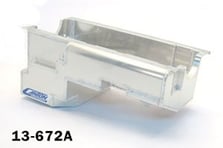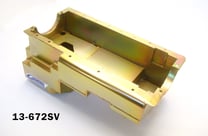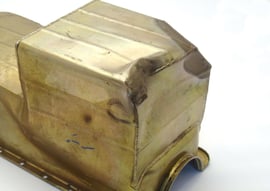A lot of people assume that an oil pan is just an oil pan. The assumption is that it holds oil and that’s it. Simple and cheap is the way to go. The only time many people think about their oil pan is when it is time for engine maintenance and they need to drain the oil. However, for the more dedicated of auto enthusiasts an oil pan and subsequently an entire oiling system can be a matter of engine life and death. Many enthusiasts know that there are 3 types of basic oiling systems. (Click here to read that blog). Beyond the types of oiling systems there are specifics about how to set them up. With many different types and options for oiling systems we could go on for days. However, here we are just going to focus on the two most common materials used for oil pans.
In this post we will be talking mostly about fabricated performance oil pans. These have been common in the racing industry for over 30 years. While casting oil pans is a large auto manufacturers best option, the racing industry often requires shorter runs of pans designed for specific applications. Fabricating oil pans offers the flexibility to put features like trap doors, anti-slosh baffles and power pouches into the pan to improve performance.
One of the most prevalent questions we get about oil pans is whether to use steel or aluminum. The most important factor  when choosing a material is usually the budget for the car. As a general rule aluminum pans are generally twice as expensive as steel pans. For example our 13-672A
when choosing a material is usually the budget for the car. As a general rule aluminum pans are generally twice as expensive as steel pans. For example our 13-672A  (Aluminum 351W Drag Pan) carries a retail cost of $927.60. Our 13-672SV (Steel Aluminum 351W Drag Pan) which is the same design in steel carries a cost of $512.40. The increased cost has a few different factors involved in it. These include materials, fabrication and skill required.
(Aluminum 351W Drag Pan) carries a retail cost of $927.60. Our 13-672SV (Steel Aluminum 351W Drag Pan) which is the same design in steel carries a cost of $512.40. The increased cost has a few different factors involved in it. These include materials, fabrication and skill required.
The first cost factor is that aluminum is commonly 50% more expensive than steel. How the pan is fabricated also influences final pricing. The most cost effective way to build a performance oil pan is off of a stock core. Since most stock pans are stamped steel, building off of a steel core is a common practice and often the preferred method. As for aluminum, when the stock pans are cast, the aluminum is often not very pure and is usually very porous. These two conditions create a difficult material to weld to. This drastically reduces the strength of the welds and thus the strength of the pan. Welding to a cast pan with fabricated sheet aluminum also creates two very different looking sections which can be a problem for some people. These factors make using a stock core in an aluminum application difficult and undesirable. Since building an aluminum pan off a core is not an effective option, frequently billet rails and billet seals are required to fully fabricate the oil pan rail. While this provides a great sealing surface, the billet pieces can be costly in both labor and material.
The second factor in the cost is that aluminum requires more skill and care to weld and fabricate. In addition to the increased skill it is also common to weld both inside and outside which doubles the weld time of each part. Part of the skill required to weld aluminum is due to it being a softer metal and much more prone to burn through. When welding aluminum the heat has to be applied much more carefully and consistently than when welding steel. Aluminum being softer also opens itself up to warping much easier than steel. This requires a much more thorough jig and welding procedure to ensure that the pan does not warp. There is also a much higher waste factor due to the soft nature of aluminum. Whether it is due to burn through or scratches to the surfaces the possibility of damaging parts in the welding process is much higher. All of this factors into the increased cost of an aluminum pan.
Along with the increased cost of an aluminum pan there are some distinct advantages as well as disadvantages. The largest advantage of an aluminum pan is the weight difference. The rule of thumb that we use is that an aluminum pan will save you about 1/3 of the weight of a similar steel pan. For example, Our 13-672A Oil Pan weighs 10.8 lbs. The same pan in steel 13-672SV weights 16.85 lbs. This works out to about 35% weight savings. While any weight savings is usually good, some people will argue however that this weight savings is marginalized by the fact that it is on the bottom of the motor.
The second advantage of aluminum is that the aluminum has better thermal conductivity. This allows the aluminum oil pan to draw more heat out of the oil. Typically, the surface area of the oil pan will be the determining factor of how much heat can be dissipated. However, this advantage also come with a bit of a downside. Aluminum becomes much softer at higher temperatures which can create strength problems in the event that something hits the aluminum. In comparison steel is able to hold much higher temperatures without losing it's structural integrity. Which leads us into aluminum's most glaring issue.
The most prevalent disadvantage to a fabricated aluminum pan is that they are not as strong as steel pans. If the pan is cast aluminum it will most likely crack when hit hard enough. In our experience, fabricated aluminum pans that take a hit usually have much more severe damage than we would have seen from a steel pan. Since the aluminum is much more malleable than steel what would be considered minor damage to a steel pan can be much more fatal to an aluminum pan. Additionally,  once a fabricated aluminum pan is damaged they are commonly expensive to repair when they are even worth repairing. This is also assuming that the rail was not damaged beyond repair. When compared to an aluminum pan, a steel pan holds it shape much better than aluminum and is often salvageable or repairable often times even still while at the track. The image here is of a Canton oil pan for a 351W that was used in rock racing. The crew took a hard hit to the oil pan but were able to seal it and keep racing that weekend. The only leak from this pan came from the drain plug threads being damaged. As long as you still have proper pickup clearance a steel pan can keep going.
once a fabricated aluminum pan is damaged they are commonly expensive to repair when they are even worth repairing. This is also assuming that the rail was not damaged beyond repair. When compared to an aluminum pan, a steel pan holds it shape much better than aluminum and is often salvageable or repairable often times even still while at the track. The image here is of a Canton oil pan for a 351W that was used in rock racing. The crew took a hard hit to the oil pan but were able to seal it and keep racing that weekend. The only leak from this pan came from the drain plug threads being damaged. As long as you still have proper pickup clearance a steel pan can keep going.
In the world of racing you can't win if you can't finish. While there are distinct advantages to a fabricated aluminum oil pan, it often times makes sense both financially and practically to go with a steel oil pan. Once you have decided the material of the pan you will need to decide how to set up the rest of your oiling system. To learn about different oiling systems check out our blog here.
If you want to know more about engine oil & what it does click below & get our Engine Oil E-book.

